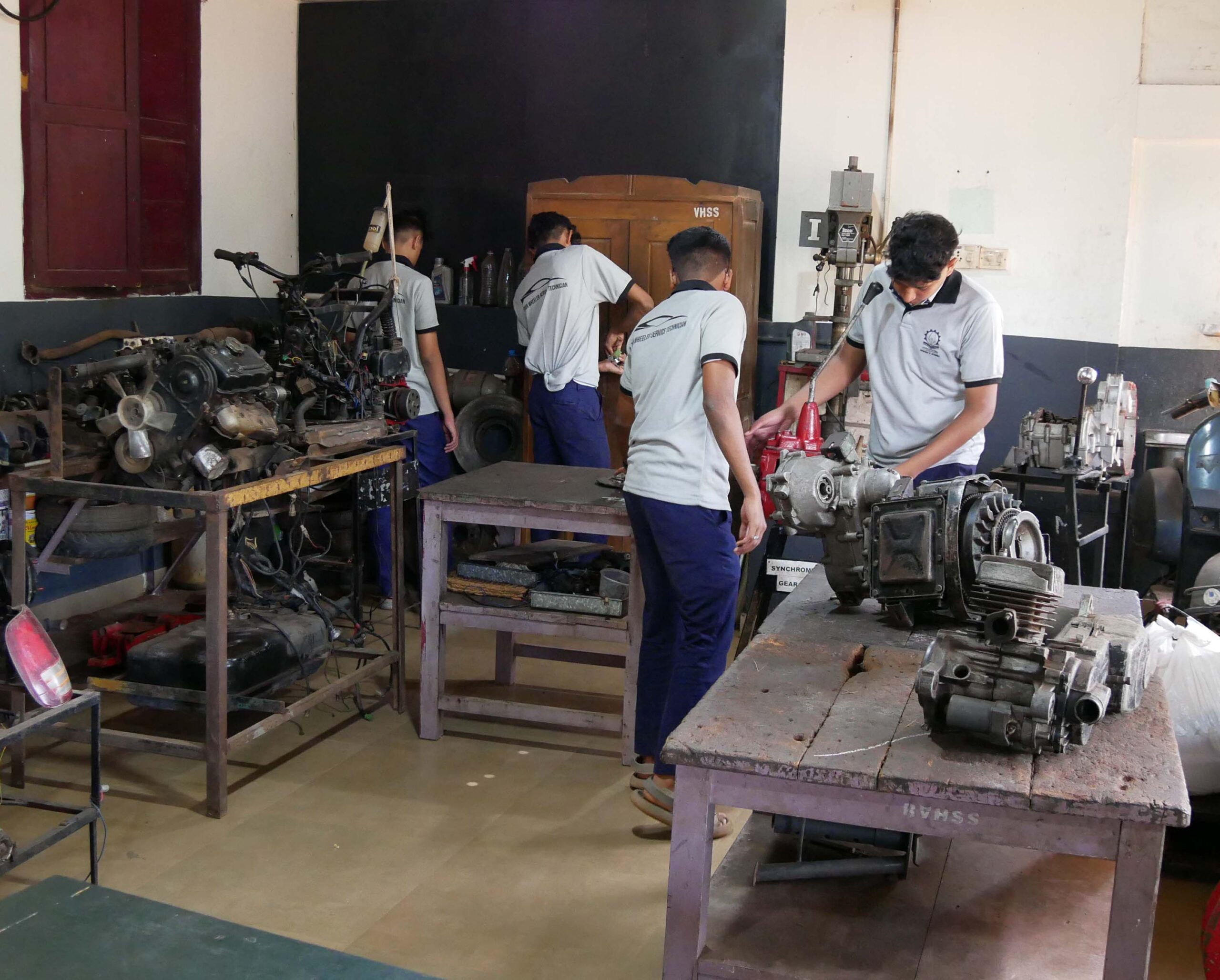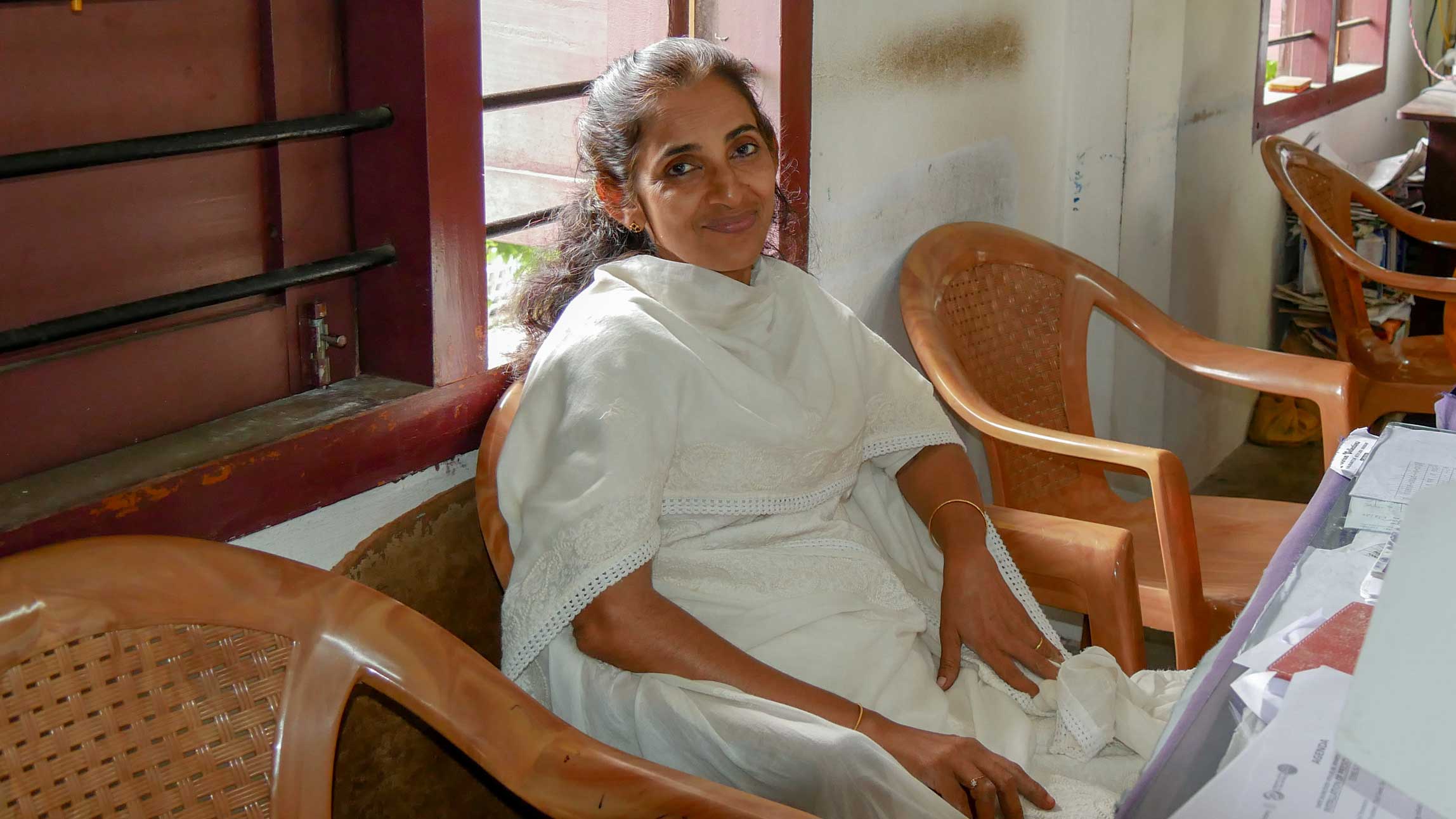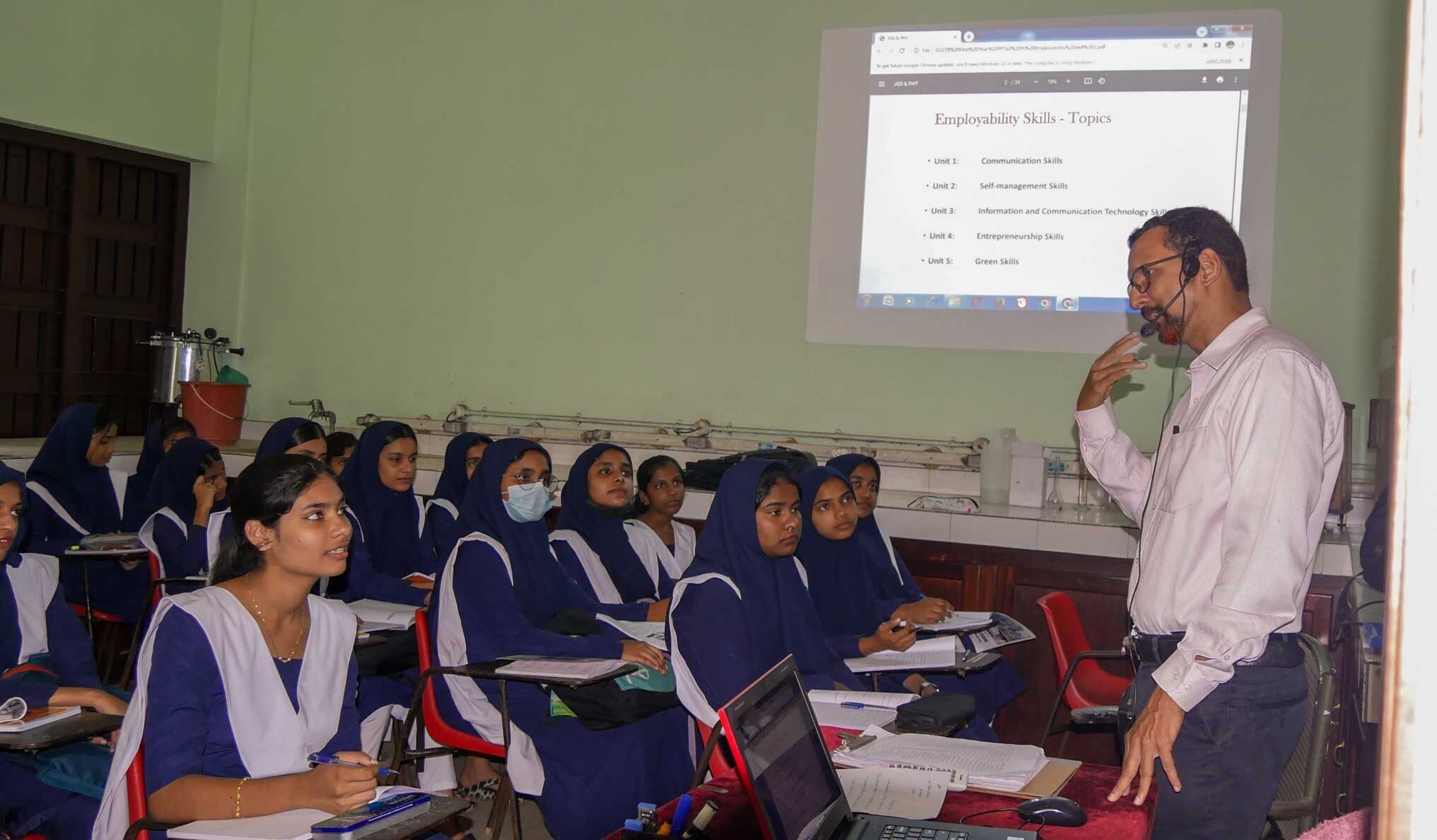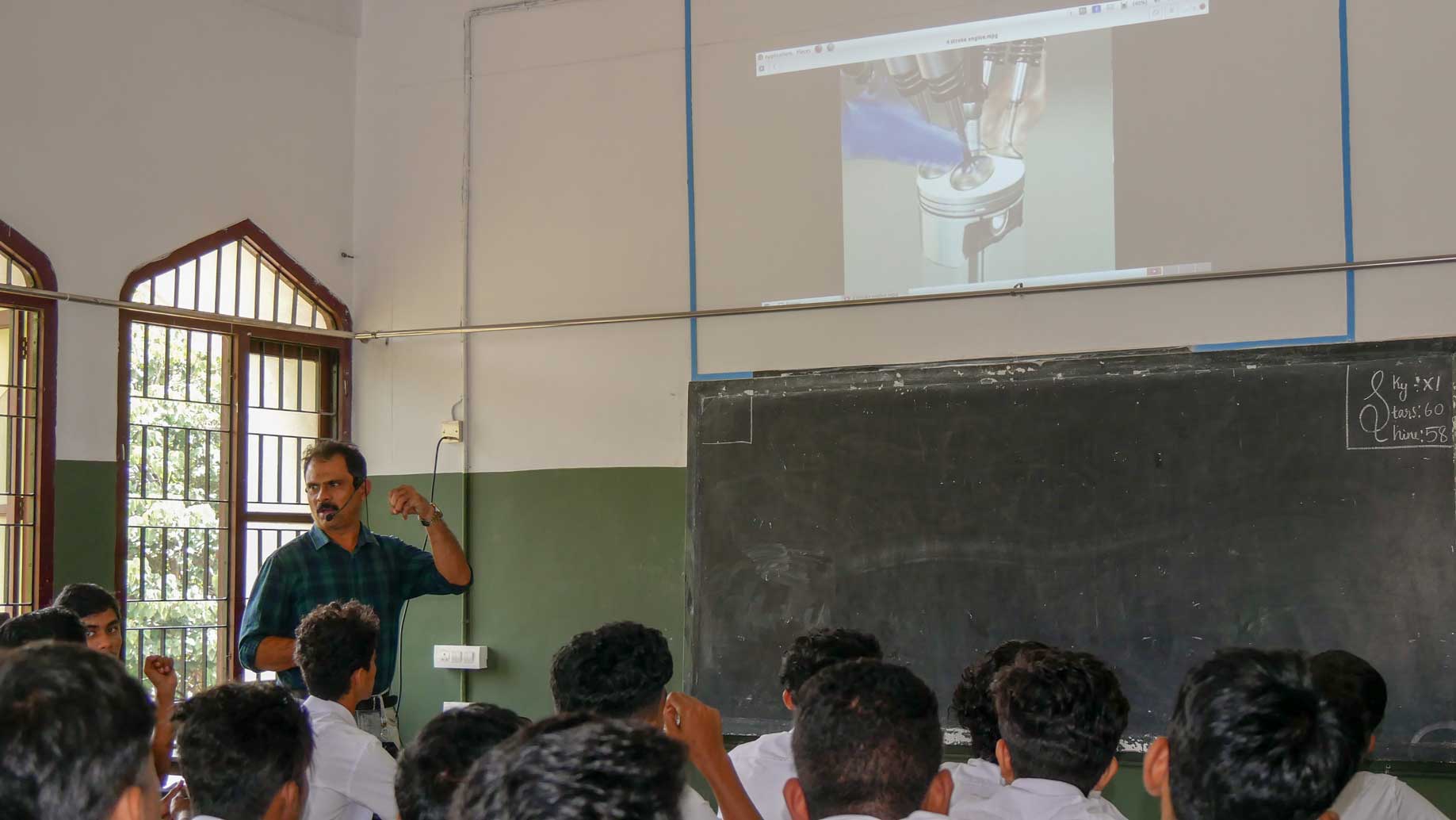Vocational Higher Secondary Schools
“People do not know about these courses. When I told people I had taken this course, the general reaction was, ‘Why this course?’ There is a stereotype that only students with less marks would opt for the Vocational Higher Secondary Schools (VHSS) courses.”
– Krishnindhu, VHSS student, 24 July 2023

Lace Making, Embroidery, and Sewing were taught in mission schools from the nineteenth century. Image: University of Southern California Digital Library, 1937
Skill-based education was essential to the modern schools introduced by missionaries in Malabar, Cochin, and Travancore in the early nineteenth century. Later, when the various governments in these regions took up the responsibility of formal education in the mid-nineteenth to early twentieth centuries, they carried forward the importance given to skill-based or technical education.
In 1983, the Kerala government introduced Vocational Higher Secondary Education (VHSE) with a limited selection of courses in 19 schools, but soon expanded to include disciplines ranging from technology, healthcare, hospitality, and commerce to arts and crafts. In 2018-19, the National Skill Qualifications Framework (NSQF) was implemented for vocational courses all over India, including Kerala.
“NSQF gives vocational training to students in classes 11–12. At least 30 per cent of the student population needs to be given training in trade.”
– Dr Anil Kumar R. Kurup, VHSS teacher, Thrissur, 2023

St. Ignatius VHSS, Kanjiramattom, Ernakulam. Image: JANAL Archives, 2023

Students working in a technical laboratory, St. Ignatius VHSS, Kanjiramattom. Image: JANAL Archive, 2023

Biju Kuriakose, clerk at St. Ignatius VHSS. Image: JANAL Archives, 2023
St. Ignatius VHSS, Kanjiramattom
St. Ignatius School was started in 1939 as an upper primary school near St. Ignatius Church in Kanjiramattom. The St. Ignatius VHSS was started in 1991 and was the first aided VHSS in Kerala.
“I studied in a VHSS in 1984–86. I did a course related to agriculture that helped me to try innovative methods in cultivating my parambu (garden plot).”
– Biju Kuriakose, Clerk, St.Ignatius VHSS, 2023

High School Section of Rahmaniya for the Hearing and Visually Impaired Students, Kozhikode. Image: JANAL Archives, 2023
Rahmaniya VHSS, Kozhikode
In 1973 the Association for Welfare of Handicapped (AWH) started the Rahmaniya School for Handicapped to provide vocational and all-round development for children with special needs. The Rahmaniya VHSS was started in 1991 to continue providing vocational support to deaf students (hearing-impaired, HI, is the term used by the staff to refer to the students) in the Rahmaniya School.
The Subjects in a Vocational HSS
“Vocational Course was thought of as a terminal course by the Centre due to the high school dropout rate in North India. In Kerala, the trend of doing higher studies has made this into a transitional course. Though the idea was that the course would enable the student to enter a trade directly, that has not happened.”
– Dr Anil, VHSS teacher, Thrissur, 2023
A VHSS course in a school typically has five subjects—a vocational course, a language, and three other subjects. In an HSS, the students would learn two languages and three other subjects. In Kerala, because of the high levels of education, VHSS students prefer to go for higher education and hopes to land a “white collar” job.



Impacts of the Revision
Existing vocational courses were revamped and named to suit the new content after NSQF was implemented in 2018. These changes have altered the aspiration, demand for, and quality of specific VHS courses. For instance, renaming and changing the content of the Maintenance and Repairs of Radio and Television course into the Field Technician Computing and Peripherals (FTCP) course had enormously increased the demand for the course.
In the 1990s, The civil course in St.Ignatius VHSS was revised and renamed as the Draughtsperson. This involved incorporating new technologies, which has led to unexpected fallout.
“The teachers have also been learning new technology with the students.”
– Bessy Mathew, St.Ignatius VHSS teacher, 2023.

The Dietetic Aide Laboratory at St. Ignatius VHSS, which was earlier the MLT laboratory. Image: JANAL Archives, 2023

Jaymol Thomas, a teacher at St. Ignatius VHSS, in the staff room. Image: JANAL Archives, 2023
Hands-on Training in VHSS
The practical classes are in various modules—laboratory work, field visits, Interaction Classes with professionals in the field and so on. Practical evaluation is given equal weightage with theoretical classes. At Rahmaniya, the students are encouraged to do small projects as part of their practicals.
“We give them general guidelines on what to do and they find the engines from scrap yards. They are encouraged to dismantle these at the school lab. These add to their understanding of the working of the machines.”
– Yoonus C.P., FST teacher, Rahmaniya VHSS, 2023




Extra-curricular Education
Habeebu Rahiman T.V., a teacher at Rahmaniya, said students are given classes on entrepreneurship. The ED Club, as it is called, invites speakers to talk to the students.
Faculty from the National Institute of Technology (NIT), Indian Institute of Management (IIM), Indian Institute of Spices Research (IISR), or Centre for Water Resources Development and Management (CWRDM) are invited to give talks every year. The students are taken to these institutions and nearby industries like Milma to familiarise them with the working of machines in industries.
“They are given classes by former students who are well-placed, thus providing the students with an awareness of the possibilities of the courses.”
– Yoonus, Rahmaniya VHSS teacher, 2023

Voices from VHSS
Higher Secondary Schools, which are state funded, were started in the late 1990s when the pre-degree courses were delinked from the degree colleges. The students interviewed at Rahmaniya VHSS had been aware of the school and the courses because many of them had relatives who had studied there. These students were happy with the facilities and opportunities that they had at the school.
“Earlier, when the number of colleges and HSS were less, we would occasionally get a few brilliant students. It was the same even in the 2010s when I was doing research on VHSS in other locations.”
– Dr Anil, VHSS teacher, Thrissur, 2023
“Academically brighter students opt to take up the HSS courses that are pitched at a higher social class.”
– Saji, a retired teacher, St. Ignatius VHSS, 2023
“We have lesser opportunities and access to extracurricular activities like sports since there are only around 120–140 students in the St. Ignatius VHSS. So, we do not have enough funding for various activities.”
– Shivapriya and Vismaya, students, St. Ignatius VHSS, 2023

Students, St.Ignatius VHSS. Image: JANAL Archives, 2023
However, most students are not aware of VHSS courses or schools. They join the schools through the single window entry because the courses and institutions that are their first choice are not available. But all the students interviewed—at Ernakulam and Kozhikode—said they were happy with the courses. At St. Ignatius VHSS, the students were generally unhappy that the HSS (with 600 students) across the playground had more activities and competitions.
“I used to find Physics and Chemistry difficult at school. Now, I find it easy to study. I like that there are two hours dedicated to practicals. I hope to do a B.Tech in Mechanical or Automobile or something related after I finish the course.”
– Abhijith, FTCP student, St.Ignatius VHSS, 2023
“I want to study abroad after this.”
– Rasha Fathima, Fitness training student, Rahmaniya VHSS, 2023
“I knew about vocational courses and wanted to do one. However, I did not know much about my course when I joined. I like the course and want to do higher studies in fitness training or nutrition after this.”
– Fidha, Fitness training student, Rahmaniya VHSS, 2023

Second-year students at St. Ignatius VHSS. Image: JANAL Archives, 2023

Students at the FST laboratory in Rahmaniya VHSS. Image: JANAL Archives, 2023
Integrating the Hearing-Impaired
Currently, the Rahmaniya VHSS has only Hearing-impaired (HI) students. These students have common classes with the other students. All the teachers at the VHSS know sign language, which they have learned in various ways. All new teachers are sensitised informally so that they can better integrate the special-needs students.
“The HI students sit with the other students and attend the classes and practicals. The teachers give the HI students special instruction when needed. I give them counselling on a case-by-case basis.”
– Abdul Rahim M., Councillor, Rahmaniya VHSS, 2023
“Some of the concepts are difficult for special needs students to grasp. So, we use smart boards and audio-visual aids. Many of the students join the government polytechnic in Kozhikode. A few have gone on to do a B.Tech and study at IIM.”
– Habeebu Rahiman, Rahmaniya VHSS teacher, 2023

Hearing-Impaired students with Yoonus, Rahmaniya VHSS teacher. Image: JANAL Archives, 2023

Audio-visual aids in the classroom are useful for hearing-impaired students, Rahmaniya VHSS. Image: JANAL Archives, 2023

Teachers and Students
Vocational teachers are engineers or degree-holders in the relevant specialisations. Students said that they enjoyed having more practical courses and it gave them an edge over general HSS students.
“My mother, an MLT student here, was happy to do the course. She says that in those days the courses were different and people’s impression of the course was different.”
– Annmarie, St.Ignatius VHSS student, 2023.
“Almost 90% of the people who studied with me are employed now. This is much less in the case of those that studied Plus Two or pre-degree.”
– Seenath P., ex-VHSS student and now teacher, Rahmaniya VHSS, 2023
Gender Ratios
“The number of girl students has reduced overall. The girls join HSSs since they usually have better marks than boys. The change is not so obvious in MLT courses. Those courses used to get ten boys, then and now. That percentage has remained the same. But, in the First group and commerce courses, the percentage of girls has reduced.”
– Dr Anil, VHSS teacher, Thrissur, 2023
“In the past few years, 2–3 male students have been taking up the DIA and LTR courses. These are kids who plan to do nursing after school.”
– Praseetha E.P., LTR teacher, St. Ignatius VHSS, 2023
Given the choice, the girls are taking up subjects that have traditionally been associated with women and will lead to jobs considered appropriate for women.

In the canteen area of Rahmaniya VHSS, the number of boys outnumbers the girls. Image: JANAL Archives, 2023

Lab Technician courses have a large number of female students as opposed to other maths-based (First group) courses. Image: JANAL Archives, 2023
Vocational courses are immensely beneficial when there is adequate infrastructure, training, awareness classes, and internship programmes. In most cases, schools are not able to give importance to all these aspects due to a lack of funding or for other reasons. There is a definite difference in how vocational schools function and their position within the secondary school education system between different parts of Kerala. At Rahmaniya and generally in north Kerala, they seem to be thriving according to the staff of various VHSS. The private-aided schools there have a positive image not just in the immediate neighbourhood, but also in other locations in Kerala. They have been able to maintain their image due to funding, curricula, and infrastructure.


